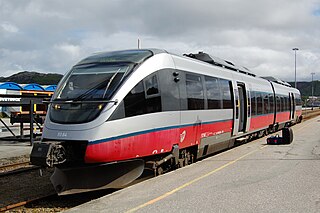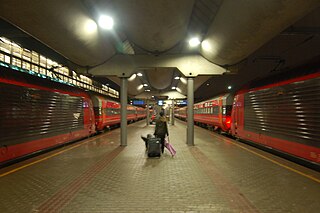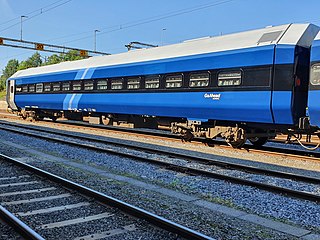
The Norwegian railway system comprises 4,109 km of 1,435 mm track of which 2,644 km is electrified and 274 km double track. There are 697 tunnels and 2,760 bridges.

Vygruppen, branded as Vy, is a government-owned railway company which operates most passenger train services and many bus services in Norway. The company is owned by the Norwegian Ministry of Transport. Its sub-brands include Vy Buss coach services, CargoNet freight trains and the Swedish train transport company Tågkompaniet. In 2009, NSB carried 52 million train passengers and 104 million bus passengers. On 24 April 2019, passenger train and bus services were rebranded as Vy.

NSB El 18 is a class of 22 electric locomotives built by Adtranz and Swiss Locomotive & Machine Works (SLM) for the Norwegian State Railways (NSB). The class is a modification of the Swiss Federal Railways Re 460 locomotive and built at Adtranz Strømmen in 1996 and 1997. The class remains the only mainline electric locomotive used by NSB, and is predominantly used on some intercity services and all night trains on the Bergen Line, Dovre Line and Sørland Line, as well as some regional trains.

The NSB El 17 is a class of twelve electric locomotives built by Thyssen-Henschel and Norsk Elektrisk & Brown Boveri (NEBB) for the Norwegian State Railways (NSB). The class was built in two batches, the first delivered in 1982 and numbered 2221–2226, and the second delivered in 1987 and numbered 2227–2232. The traction system of the El 17 was based on the DB Class 120 of Germany and were among the first in the world to feature three-phase asynchronous motors. The units were ordered to be used on the intercity Bergen, Dovre and Sørland Lines, but were plagued with technical faults. The unreliability and lack of sufficient power forced NSB to instead use them in the regional Vestfold and Gjøvik Lines. With the delivery of the El 18, the first series was retired or used as shunters. The second series has been used on the Flåm Line since 1998.

NSB Class 73 is a class of 22 electric multiple units built by Adtranz for the Norwegian State Railways. The four-car trains were modifications of Class 71, which was again based on the Swedish X2. The A-series consists of 16 intercity trains; they were delivered in 1999 and 2000 and are used on the Bergen, Dovre and Sørland Lines. The intercity service was branded as Signatur until 2003. The B-series consists of six regional trains delivered in 2002 and used on the Østfold Line. The regional trains were originally part of the Agenda concept. The trains have a power output of 2,646 kilowatts (3,548 hp) and a maximum speed of 210 km/h (130 mph). They have an overall length of 108 meters (354 ft) and have a capacity for 208 seated passengers in the A-series and 250 in the B-series. The trains have a tilting mechanism allowing for faster travel through curves.

Class 93 is a tilting two-carriage diesel multiple unit used by SJ Norge for passenger trains on non-electrified stretches of the Norwegian railway network. Used on the Nordland Line, the Røros Line and the Rauma Line, they were purchased to replace the aging Di3 locomotive-hauled trains. The Class 93 was produced by Bombardier, and is part of the Talent family. Fifteen units were delivered between 2000 and 2002.

Class 70 is a four-carriage electric multiple unit operated by Vy on medium distance trains around Oslo. They are operated on the Dovre Line between Oslo and Lillehammer / Dombås and on the Vestfold Line, operating the regional service between Lillehammer and Larvik / Skien.

NSB Di 3 is a class of 35 diesel-electric locomotives built by NOHAB for the Norwegian State Railways (NSB). The class was built between 1954 and 1969, and delivered in two series, Di 3a and Di 3b. They are based on the Electro-Motive Division F7 and are equipped with EMD 567 engines. They have a distinct bulldog nose and were numbered 602–633 (a-series) and 641–643 (b-series). The locomotives had a prime mover that gives a power output of 1,305 kilowatts (1,750 hp). The a-series has a Co′Co′ wheel arrangement, while the b-series has (A1A)(A1A). The b-series has higher top speed, but lower tractive effort.

The Trøndelag Commuter Rail is a commuter train service operating in Trøndelag county, Norway. It was operated by Vy with Class 92 diesel multiple units, until 7 June 2020 when SJ Norge took over the contract until 2030. The service provides a commuter service connecting Trondheim to its suburbs, between towns in Innherred and as an airport rail link for Trondheim Airport, Værnes. Although passenger services have operated along the lines since 1864, the commuter train was created with an increase of service with existing rolling stock in 1993. In 2019, the system was used by 1.4 million passengers.

NSB Class 66 was a three-car electric train used by the Norwegian State Railways for express trains on the Østfold Line to Halden and Gothenburg, and the Sørlandet Line to Kristiansand and Stavanger. The four multiple units were built by Skabo Jernbanevognfabrikk, with motors from Norsk Elektrisk & Brown Boveri, and delivered in 1945–46. They were originally named Class 106, but this was changed in 1956. The trains received the numbering BFM 66.01–04, B 66.31–34 and BS 66.61–64.

Night trains of Norway are night sleeping car services provided by three different operators on four routes; Vy on Oslo - Bergen, Go-Ahead Norge on Oslo - Stavanger, and SJ Norge on Oslo - Trondheim and Trondheim - Bodø.

NSB Di 1 was a class of diesel-hydraulic locomotives built by Krupp for the Norwegian State Railways (NSB). The locomotive had two MAN diesel engines, giving a combined power output of 1,472 kilowatts (1,974 hp) and allowing the 82.7 tonnes vehicle to reach a maximum speed of 100 km/h (62 mph). It had a 1'BB'1 wheel arrangement and a driver's cab at only one end.
Strømmens Værksted A/S was an industrial company based in Skedsmo, Norway, specialising in the production of rolling stock. Founded in 1873, it remains as a part of Bombardier Transportation. The plant is located just off Hovedbanen west of Strømmen Station.

NSB Class 86 is a class of diesel-hydraulic multiple units built by Strømmens Værksted for the Norwegian State Railways (NSB). Thirty-eight motor cars and thirty-one trailers were built between 1937 and 1954, split between six subtypes designated a through f. Class 91 was a further delivery of ten units that had a more comfortable interior and designed for regional trains. The trains had good acceleration and a maximum speed of 100 kilometres per hour (62 mph), which made them suitable for most unelectrified lines in Norway. As most of the network gradually became electrified, the class became increasingly used on branch lines.
NSB Class 87 is a class of 25 diesel-hydraulic railcars built by Strømmens Værksted for the Norwegian State Railways. Seventeen a-series units were delivered in 1941 and equipped with 93-kilowatt (125 hp) Deutz prime mover. Eight b-series units were delivered in 1952 and equipped with 110-kilowatt (150 hp) Scania-Vabis prime movers. The trains weighed 15 and 15.5 tonnes and had a maximum speed of 75 and 80 kilometres per hour, respectively for the a and b-series. They were used on many branch lines until the 1960s, when the gradual electrification caused most lines instead to be served with Class 86. The a-series was scrapped in 1972 and 1973, while the b-series remained used between Ål and Hønefoss on the Bergen Line until 1975 and on the Flekkefjord Line until 1981.
NSB Class 88 was a class of six three-car diesel-hydraulic multiple units built by Strømmens Værksted for the Norwegian State Railways. Derived from the German DRG Class SVT 877, the trains were the diesel counterpart of Class 66. The trains were built as express trains on the Bergen Line and the Dovre Line, serving the routes from Oslo to Bergen and Trondheim. The first four units were delivered in 1945 and 1946, but mechanical failures caused them to highly unreliable until 1950. Two more units were delivered in 1958. Retirement started in 1963 and from 1965 the trains were moved to the Røros Line. They left regular service from 1970 and were chopped three years later.
Norges Statsbaner (NSB) operates as of January 1, 2008 36 locomotives, 191 multiple units and 206 passenger carriages.

NSB Class 5 or B5 is a series of passenger carriages built by Strømmens Værksted for the Norwegian State Railways. Built between 1977 and 1981, they went through a major upgrade between 2008 and 2012. Sixty-three units were delivered. Each is 25.30 metres long, 3.10 metres wide, and 4.075 metres tall. They weigh 42 tonnes and have a maximum permitted speed of 160 kilometres per hour (99 mph). They are used predominantly on the Dovre Line, the Nordland Line and the Vestfold Line.

Norsk Spisevognselskap A/S, often abbreviated NSS or shortened to Spisevognselskapet, was a Norwegian state enterprise which operated restaurant carriages on Norwegian trains and restaurants at railway stations and railway hotels. The company was established in December 1918, and started a catering service in 1919. Originally owned by the Norwegian Trunk Railway, it was acquired by the state in 1926. Meals served in the restaurant carriages were relatively expensive, although they were available to all passengers. In the 1950s, the company began using serving trolleys on trains.

NSB WLAB-2 or WLAB2 is a class of twenty sleeping cars built by Strømmens Verksted for the Norwegian State Railways (NSB). They serve as the sole sleepers in Norway, being used on the Bergen Line, Dovre Line, Nordland Line and Sørlandet Line. Each car features fifteen compartments, which can each be utilized with a single or twin bunk configuration. The carriages have a unique octagonal shape, are 27 meters long and weigh 48 tonnes.


















